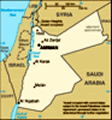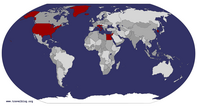Advertisement
Published: March 9th 2020
Unexpected things happen when you travel. Today we were supposed to go to Karak as our 3rd visit, but there are demonstrations and GAdventures felt it was too dangerous for us to go. The demonstrations were due to the plan to move the bus station from the inside to the outside which would affect all the merchants and their income. The crowds were supposedly controlled with tear gas. I can't find any news about it.
Our first stop was to Mt. Nebo, the spot where Moses was told where the Holy Land is, and this is where he died.
According to the final chapter of the
Book of Deuteronomy, Moses ascended Mount Nebo to view the
Land of Canaan, which God had said he would not enter; he died in Moab.
According to
Christian tradition, Moses was buried on the mountain, although his place of burial is not specified (
Deuteronomy 34:6). Some
Islamic traditions also stated the same,
although there is a grave of Moses located at
Maqam El-
Nabi Musa, 11 km (6.8 mi) south of
Jericho and 20 km (12 mi) east of
Jerusalem in the
Judean wilderness.
Scholars continue to dispute whether the mountain currently known
as Nebo is the same as the mountain referred to in Deuteronomy.
According to
2 Maccabees (
2:4–7), the prophet
Jeremiah hid the tabernacle and the
Ark of the Covenant in a cave there.
On March 20, 2000,
Pope John Paul II visited the site during his pilgrimage to the Holy Land.
During his visit he planted an
olive tree beside the Byzantine chapel as a symbol of peace.
Pope Benedict XVI visited the site in 2009, gave a speech, and looked out from the top of the mountain in the direction of Jerusalem.
A serpentine cross sculpture (the
Brazen Serpent Monument) atop Mount Nebo was created by Italian artist Giovanni Fantoni. It is symbolic of the bronze serpent created by Moses in the wilderness (
Numbers 21:4–9) and the cross upon which Jesus was crucified (
John 3:14).
On the highest point of the mountain, Syagha,
the remains of a Byzantine church
and
monastery were discovered in 1933.
The church was first constructed in the second half of the 4th century to commemorate the place of Moses' death. The church design follows a typical
basilica pattern. It was enlarged in the late fifth century AD and rebuilt in AD

 3 Faces on People of the Book Rock
3 Faces on People of the Book Rock
The book means book for Christians, Muslims, and Jews.597. The church is first mentioned in an account of a
pilgrimage made by a lady
Aetheria in AD 394. Six tombs have been found hollowed from the natural rock beneath the
mosaic-covered floor of the church.
Bellarmino Bagatti worked on the site in 1935.
Virgilio Canio Corbo later excavated the interior of the basilica. In 1963, he was put in charge of restoring the original pavements for exhibition.
In the modern chapel
presbytery, built to protect the site and provide worship space, remnants of mosaic floors from different periods can be seen. The earliest of these is a panel with a
braided cross presently placed on the east end of the south wall.
The Moses Memorial that houses the Byzantine mosaics was closed for renovation from 2007 to 2016. It reopened on 15 October 2016.
Next stop was the Madaba mosaics. It is best known for its
Byzantine and
Umayyad mosaics, especially a large Byzantine-era mosaic map of the Holy Land. Madaba is located 30 kilometres (19 miles) south-west of the capital
Amman.
The first mosaics were discovered during the building of new houses using
bricks from
older buildings. The new
inhabitants of Madaba, made conscious of the importance of the mosaics by their priests, made sure that they took care of and preserved all the mosaics that came to light.
The northern part of the city turned out to be the area containing the greatest concentration of mosaics. During the Byzantine-Umayyad period, this northern area, crossed by a colonnaded
Roman road, saw the building of the Church of the Map, the Hippolytus Mansion, the Church of the Virgin Mary, the Church of Prophet Elijah with its crypt, the Church of the Holy Martyrs (Al-Khadir), the Burnt Palace, the Church of the Sunna' family, and the church of the salaita family.

A 6th-century mosaic map of Jerusalem in the
Madaba Map The
Map of Madaba mosaic was discovered in 1896 and the findings were published a year later. This discovery drew the attention of scholars worldwide. It also positively influenced the inhabitants, who shared the contagious passion of
F. Giuseppe Manfredi, to whom the rediscovery of most of the city's mosaics are owed. Madaba became known as the "City of Mosaics" in Jordan.
The Madaba Mosaic Map is a map of the region dating from the 6th century and preserved in
the floor of the
Greek Orthodox Basilica of
Saint George, sometimes called the "Church of the Map". With two million pieces of colored stone, the map depicts hills and valleys, villages and towns in Palestine and the Nile Delta. The mosaic contains the earliest extant representation of Byzantine
Jerusalem, labeled the "Holy City." The map provides important details about its 6th-century landmarks, with the
cardo, or central colonnaded street, and the church of the
Holy Sepulchre clearly visible. This map is one key in developing scholarly knowledge about the physical layout of Jerusalem after its destruction and rebuilding in 70 AD.
Other mosaic masterpieces found in the Church of the Virgin and the Apostles and the Archaeological Museum, depict a profusion of flowers and plants, birds and fish, animals and exotic beasts, as well as scenes from mythology and everyday pursuits of hunting, fishing and farming. Hundreds of other mosaics from the 5th through the 7th centuries are scattered throughout Madaba.
Third stop was Little Petra:
Little Petra (
Arabic: البتراء الصغيرة,
al-batrā aṣ-ṣaġïra), also known as
Siq al-Barid (
Arabic: سيق البريد, literally "the cold canyon") is an
archaeological site located north of
Petra and the town of
Wadi Musa in the
Ma'an Governorate of
Jordan. Like Petra, it is a
Nabataean site, with buildings carved into the walls of the
sandstone canyons. As its name suggests, it is much smaller, consisting of three wider open areas connected by a 450-metre (1,480 ft) canyon. It is part of the Petra Archeological Park, though accessed separately, and included in Petra's inscription as a
UNESCO World Heritage Site.
It is often visited by tourists in conjunction with Petra itself, since it is free and usually less crowded.
Like Petra, it was probably built during the height of Nabataean influence during the 1st century C.E. While the purpose of some of the buildings is not clear,
archaeologists believe that the whole complex was a
suburb of Petra, the Nabatean capital, meant to house visiting traders on the
Silk Road. After the decline of the Nabataeans, it fell vacant, used only by
Bedouin nomads, for centuries. Along with neighboring
Beidha, Little Petra was excavated in the later 20th century by
Diana Kirkbride and Brian Byrd.
In 2010, a biclinium, or dining room, in one of the caves was discovered to have surviving interior art depicting grapes, vines and
putti in great detail with a varied
palette,
probably in homage to the Greek god
Dionysus and the consumption of wine. The 2,000-year-old ceiling
frescoes in the
Hellenistic style have since been
restored. While they are not only the only known example of interior
Nabataean figurative painting in situ, they are a very rare large-scale example of Hellenistic painting, considered superior even to similar later Roman paintings at
Herculaneum Little Petra is in an arid, mountainous desert region 1,040 metres (3,410 ft) above sea level. To the east the
Arabian Desert opens up. On the west the rugged terrain soon descends into the
Jordan Rift Valley, with lands around the
Dead Sea as low as 400 metres (1,300 ft) below sea level.
It is on the local road that leaves
Wadi Musa and follows the edge of the mountains around
Petra itself through the small
Bedouin village of Umm Sayhoun. About 8 kilometres (5.0 mi) north of Wadi Musa, a short road to the west leads to the small, unpaved parking lot for Little Petra
and
Beidha, a
Neolithic site nearby. There is another small Bedouin settlement 1 km (0.6 mi) to the east.
_Little_Petra%!C(MISSING)_Jordan.jpg/200px-Siiq_al-Bariid%!C(MISSING)_Little_Petra%!C(MISSING)_Jordan.jpg)
The Siq al-Barid
From the parking lot Siq al-Barid opens up
in the rock facade to the west southwest. Its name, literally "cold canyon", comes from its orientation and its high walls preventing the entry of most available sunlight. The modern name "Little Petra" comes from its similarities to the larger site to the south—both must be entered via a narrow canyon, and consist primarily of Nabataean buildings.
The canyon widens after 400 metres (1,300 ft).
In this open area many of the
sandstone walls have had openings carved into them; they were used as dwellings. On the south face is a
colonnaded triclinium with a projecting
pedimented portico that archaeologists believe was used as a temple, though they know very little about it.
The canyon then narrows again for another 50 m (150 ft),
leading to another, smaller open area. The carved openings are even more numerous here, including four large triclinia. Archaeologists believe these spaces could have been used to entertain visiting merchants.
On the south side is a small biclinium. It has some rare surviving
Nabataean paintings on its rear wall, and so it is called the Painted Room.
Opposite the room on the
north is a large
cistern, part of the water system built by the original inhabitants.
At the west end of the canyon a set of steps leads to the top of the rock. There are panoramic views available of the entire Petra region.
A lightly-used foot trail leads from there to Ad-Deir at Petra, 6 kilometres (3.7 mi) to the southwest.
We finally arrived at our hotel after a long day with lots of driving. We had a group dinner, with the main course maqlouba - chicken, vegetables and rice cooked in a pot.
Maqluba or Maqlooba (
Arabic: مقلوبة) is a traditional
Syrian,
Iraqi,
Palestinian,
and
Jordanian dish served throughout the
Levant. It consists of meat, rice, and fried vegetables placed in a pot which is flipped upside down when served, hence the name
maqluba,
which translates literally as "upside-down." The dish goes back centuries and is found in the
Kitab al-Tabikh, a collection of 13th century recipes.
Advertisement
Tot: 0.098s; Tpl: 0.017s; cc: 12; qc: 27; dbt: 0.0188s; 1; m:domysql w:travelblog (10.17.0.13); sld: 1;
; mem: 1.2mb








_Little_Petra%!C(MISSING)_Jordan.jpg/200px-Siiq_al-Bariid%!C(MISSING)_Little_Petra%!C(MISSING)_Jordan.jpg)


 Maroon
Maroon 













